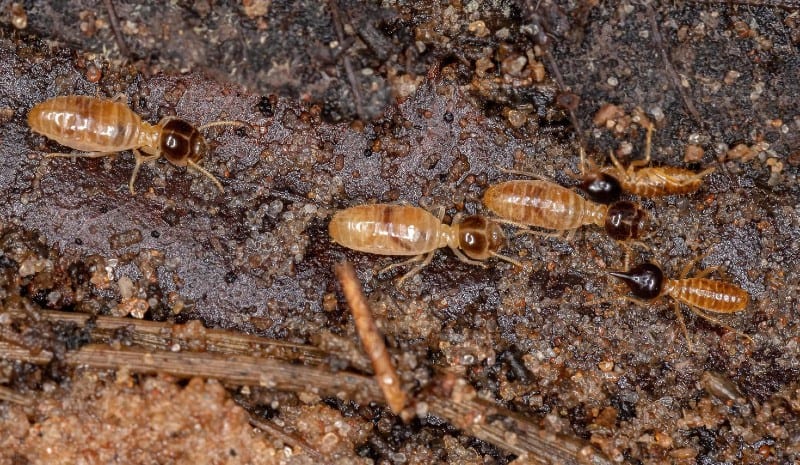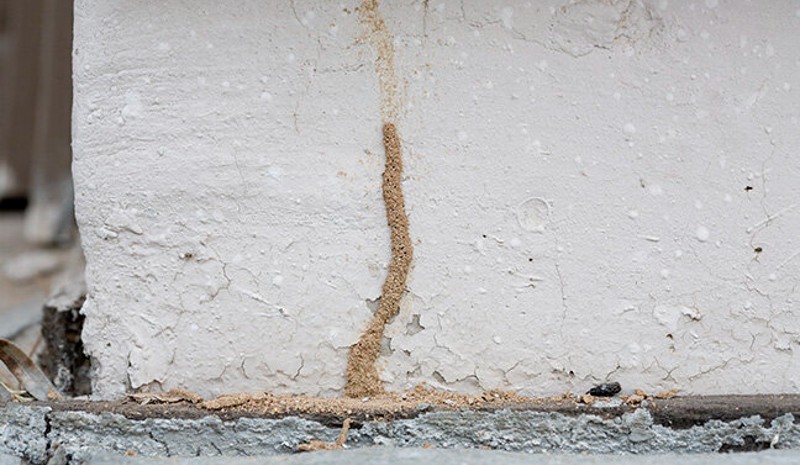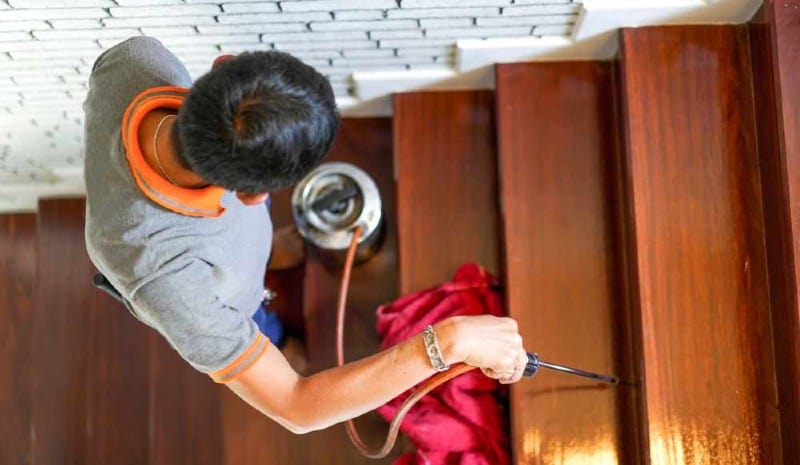Dietary Differences Between Drywood and Dampwood Termites
When it comes to termite infestations and damage, understanding the dietary habits of different termite species can be incredibly important for prevention and control measures. Two types of termites commonly found in homes are drywood and dampwood termites, and while they both consume wood and other materials, their diets can differ significantly. Let’s take a deeper look at what drywood and dampwood termites eat and how it impacts their behavior and impact on your home’s structure. For more information on termite feeding patterns and behaviors, check out our article on termite feeding habits.

Drywood Termites Diet
Drywood termites are known for their feeding habits, which may significantly differ from other termite species. These termites infest dry wood and do not require any contact with the soil. Their diet mainly consists of wood and cellulose-based materials.
The table below highlights the drywood termite’s diet:
| Drywood Termite’s Diet | Description |
|---|---|
| Wood | Drywood termites infest dry wood, and they feed on it, even if it might not be suitable for them. They consume all parts of the wood, including the cellulose, lignin, and hemicellulose. |
| Dead Wood | Drywood termites are also known to infest dead wood structures, including lumber, tree stumps, and dead tree branches. |
| Utility Poles | Drywood termites can infest poles made of wood as they provide them with their required nutrients. |
It is essential to note that drywood termites are unique, and their diet is somewhat exclusive. In contrast to subterranean termites that need soil contact, drywood termites do not require it for survival and can continue to thrive in dry wood with low moisture content.
Want to know more about the relationship between termites and wood? Check out our-article on termite-wood relationship.
Dampwood Termites Diet
Dampwood termites have a completely different diet compared to their drywood counterparts. Rather than feeding on dry wood, they prefer moist and decaying wood. In fact, their name ‘dampwood’ is derived from their preference for such types of wood. The following table summarizes the dietary requirements of dampwood termites.
| Dietary Category | Examples |
|---|---|
| Wood | Moist and decayed wood (logs, stumps, fallen trees) |
| Other Plant Matter | Dead leaves, ferns, and some grasses |
| Fungi | Dampwood termites can also consume fungus found growing in damp areas of their environment |
Dampwood termites are different from subterranean termites, as they do not require soil or moisture in their nests. Rather, they prefer to live close to their food source in the above-ground portions of the tree or wood. Their diet of moist and decaying wood is typically found in trees that have been dead or have fallen to the ground, making them more susceptible to infestation.
Although their diet is not as destructive as drywood termites, dampwood termites can still cause damage to homes and other structures if their preferred food source is available inside. It is important to be mindful of any leaks or sources of moisture that may attract dampwood termites to your property.
One interesting fact about dampwood termites is that they have gut microbes that help to digest the cellulose found in wood. These microbes are essential to the dampwood termite’s ability to digest wood efficiently and extract the necessary nutrients. In fact, the digestive system of the termite is so effective that their feces are often indistinguishable from the wood they consumed.
Understanding the dietary differences between drywood and dampwood termites is important for identifying and preventing infestations. By knowing what termites eat and their preferences, it is possible to take steps to reduce their attraction to your property. For more information on termite diets and feeding patterns, check out our article on termite feeding patterns.
Identification of Drywood and Dampwood Termites
Identifying the specific type of termites that infest your home is crucial to determine the most effective control measures. Drywood and dampwood termites have varying appearances and signs of infestation. It is important to take note of these distinctions to address the root cause of the termite problem. Understanding the differences between drywood and dampwood termites can save you from costly damage to your property. Let’s dive in to explore how to identify drywood and dampwood termites.
Physical Appearance
Termites are known for their destructive nature and it is crucial to be able to identify the species to implement an effective control strategy. One way to differentiate between drywood and dampwood termites is through their physical appearance. Here are the key features that distinguish them:
- Drywood termites – These termites are typically larger than dampwood termites and have a brownish or reddish color. They have straight, beaded antennae and their wings are clear and have few veins. Drywood termite soldiers have a large, rectangular head with strong mandibles used for defense.
- Dampwood termites – These termites are usually smaller and have a lighter color compared to drywood termites. Their wings are opaque and have distinct veins, and their antennae are branched or clubbed. Dampwood termite soldiers have a rounded head and mandibles that are not as pronounced as drywood termites.
It is important to note that physical appearance can vary within each species, so it is important to look for multiple indicators to confirm the presence of termites. If you are unsure which species of termite you are dealing with, contact a pest control professional for assistance.
Understanding the physical appearance of termites can help you identify which species is causing damage to your home and can inform the appropriate treatment method. Speaking of termite diet, check out our article
How Termite Nutrition Affects Your Home for more information on how termite diet impacts their behavior and the damage they can cause.
Infestation Signs

Spotting an infestation of termites in your home can be a tricky task, especially if you have no knowledge of the visible signs that can indicate there is a problem. Here are some potential indicators to watch out for:
- Mud Tubes: These are long, narrow tubes or tunnels made of mud that you might see running along walls or foundations. Termites use them to travel in and out of your house.
- Discarded Wings: You might find piles of discarded wings near baseboards, windowsills or other entry points. When termites leave their colonies to mate and form new colonies, they shed their wings once they settle into a new location.
- Bumpy or Distorted Paint: If you notice paint on walls and wood surface that appears to be bubbled or distorted, it could be a sign of termites burrowing beneath it.
- Hollow-sounding Wood: When termites eat away at the inside of wood, there is very little outward evidence of the damage. If you tap on the wood surface and it sounds hollow, there could be a hollow area beneath the surface.
- Fecal Pellets: Drywood termites push their fecal pellets out of their galleries (tunnels) and they appear as small piles of tiny pellets. They look like sawdust or sand, and they can accumulate near the infested area.
Sometimes these signs can be hard to spot, and by the time you notice something is wrong, the problem might already be severe. If you do happen to notice any of these signs, it is important to call a professional pest control company for inspection and treatment immediately. Delaying treatment could put your home at risk of significant damage by termites, which can be very costly to repair.
Understanding the termite diet and behavior is also a key factor in spotting an infestation, as this can help you identify the areas in your home that could be most vulnerable to termite damage. Knowing that dampwood termites prefer wet or decaying wood, and drywood termites live in dry, undecayed wood can help you determine where to look for infestation signs. Learning about termite digestion and the role of gut microbes in this process can also provide invaluable insight into these insect’s habits. Understanding how termites modify the landscape in order to locate food and avoid predators can also help you identify potential infestation sites in and around your home.
Prevention and Control Tips
Protecting your home against termites should be a top priority for every homeowner. Once they infest your home, the damage they can do to its structure can be costly to fix. To prevent this from happening, there are various precautionary steps you can take. In this section, we’ll go over several prevention and control tips that will help minimize your risk of a termite infestation. But first, let’s review what termites eat and how knowing their diet can help prevent infestation.
Prevention
Prevention is always better than cure, and this is especially true when it comes to termites. Here are some effective tips to prevent termite infestations:
- Eliminate Moisture: Termites are attracted to moisture, so it’s essential to keep your home dry. Fix any plumbing leaks, seal any leaks in your home’s foundation, and ensure proper drainage away from your home. Make sure to ventilate your attic and crawl space to reduce moisture buildup.
- Remove Food Sources: Termites feed on wood and plant fibers, so it’s important to remove any food sources that could attract them. Store firewood away from your home, don’t use mulch near the foundation, and remove any dead trees or stumps on your property.
- Seal Entry Points: Termites can enter your home through cracks in the foundation or walls, so it’s essential to seal any entry points. Seal cracks around windows and doors, add screens to vents, and use weatherstripping to seal gaps in the doors.
- Regular Inspections: Regular inspections are crucial in identifying and preventing termite infestations. Hire a professional pest control company to conduct annual inspections or conduct them yourself using a flashlight and a screwdriver to check for hollowed-out wood and mud tubes.
- Termite-Resistant Materials: Use termite-resistant materials whenever possible. For example, treated lumber and concrete block are less attractive to termites than untreated wood.
By following these prevention tips, you can reduce the risk of termite infestations in your home and avoid costly damage. If you want to learn more about what termites eat, check out our article on what termites eat.
Treatment Options

When facing a termite infestation in your home, it’s crucial to take swift action to prevent further damage. Here are some treatment options that can effectively eliminate both drywood and dampwood termites:
| Treatment Options | Pros | Cons |
|---|---|---|
| Chemical Treatments | -Proven to be effective -Can provide long-lasting protection -Can treat a large area |
-Requires professional application -May require multiple treatments -Can be toxic to humans and pets |
| Baiting Systems | -Targets entire colony -Less toxic than chemical treatments -Easy to maintain |
-Takes time to work -May not be effective against severe infestations -Can be costly |
| Heat Treatment | -Effective against all life stages of termites -Non-toxic -Environmentally friendly |
-Requires professional equipment -May not penetrate all areas of the infested wood -Can be costly |
| Fumigation | -Can penetrate all areas of infested wood -Effective against all life stages of termites -Provides long-lasting protection |
-Requires professional application -Can be expensive -Can be toxic to humans and pets |
Chemical treatments are the most common and effective way to eliminate termites. These treatments involve the use of chemicals that either kill termites on contact or are ingested by termites and spread throughout the colony. However, these treatments require professional application and can be toxic to humans and pets.
Baiting systems are another effective treatment option. These systems involve placing bait stations around the perimeter of the home. Termites ingest the bait, which contains a slow-acting poison. The poison is then spread to other termites in the colony, eventually eliminating the entire colony. However, baiting systems can take time to work and may not be effective against severe infestations.
Heat treatments involve using special equipment to raise the temperature in the infested area to a level that kills termites. This treatment is non-toxic and environmentally friendly, but can be expensive and may not penetrate all areas of the infested wood.
Fumigation is a treatment option that involves covering the infested area with a tent and releasing a gas that kills termites. This treatment is effective against all life stages of termites and provides long-lasting protection. However, it requires professional application and can be toxic to humans and pets.
It’s important to note that all of these treatment options require professional application and should not be attempted by homeowners. It’s also important to consult with a licensed pest control professional to determine the most effective treatment plan for your specific situation.
Conclusion
In conclusion, understanding the dietary differences between drywood and dampwood termites is essential for identifying and effectively treating a termite infestation. Drywood termites consume drywood and hardwood, while dampwood termites prefer damp and decaying wood. Knowing these differences can help homeowners identify which species is causing damage to their home.
Identifying the physical appearance and typical infestation signs of drywood and dampwood termites is also important when dealing with an infestation. Drywood termites are typically smaller and lighter in color than dampwood termites, and they may leave behind fecal pellets that are similar in color to the wood they are consuming. Dampwood termites may leave behind mud tubes or piles of frass around infested areas.
To prevent termite infestations, homeowners should take steps to eliminate moisture in and around their home, repair any leaks or water damage, and avoid storing wood near the foundation. Treatment options for termite infestations include chemical treatments, fumigation, and heat treatments, and a professional pest control service can help determine the most effective option for a specific infestation.
Ultimately, identifying and addressing termite infestations early is key in preventing costly damage to a home. By understanding the dietary differences and identification methods of drywood and dampwood termites, as well as utilizing prevention and treatment methods, homeowners can protect their homes from these destructive pests.
Frequently Asked Questions
1. Can both drywood and dampwood termites infest my home?
Yes, depending on the type of wood and the moisture content, both species can infest your home.
2. How can I identify drywood termites?
Drywood termites have a creamy white or light brown color and are slightly larger than dampwood termites. They also produce small fecal pellets that are hexagonal in shape.
3. How can I identify dampwood termites?
Dampwood termites have a yellowish-brown color and are larger than drywood termites. They also require higher levels of moisture and are commonly found in damp or decaying wood.
4. What do drywood termites eat?
Drywood termites consume dry and sound wood, including hardwood and softwood, as well as other cellulose-based materials like paper and cardboard.
5. What do dampwood termites eat?
Dampwood termites feed on decaying wood, including trees, logs, and stumps. They also infest damp or water-damaged wood in homes.
6. How can I prevent termite infestations?
Regularly inspecting for moisture issues, sealing cracks and gaps in the foundation and walls, and removing any wood debris around your home can help prevent termite infestations.
7. What treatment options are available for termite infestations?
Chemical treatments, such as liquid termiticides and baits, can effectively treat termite infestations. Heat treatments and fumigation are also options for more severe infestations.
8. Can I treat termite infestations myself?
While DIY treatments are possible, professional treatment is often recommended for the most effective and long-lasting results.
9. How long does termite treatment typically last?
The length of termite treatment largely depends on the severity of the infestation. Some treatments may provide long-lasting protection for up to 10 years.
10. What should I do if I suspect a termite infestation in my home?
You should contact a pest control professional immediately to schedule an inspection and treatment plan. Early detection and treatment can prevent significant damage to your home.

